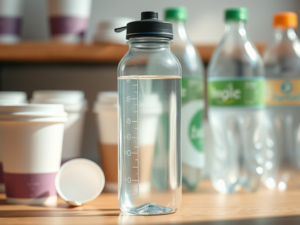
Environmental concerns have driven people to seek products that are not derived from petroleum. This has translated into people using products from renewable resources for serving food and beverages. Now you are drinking iced tea out of corn plastic cups or coffee from paper cups labeled as ecofriendly. What does this label mean and what do you do with them when you have consumed your beverage?
What is PLA?
Corn plastic is called polylactic acid or PLA. It is derived from corn as well as other starch-rich crops like sugar beets and wheat. The starch is isolated from the source crop, and dextrose (a sugar) is then processed from the starch and fermented to lactic acid. This product can be polymerized to create PLA, which is then processed into cups and containers used to hold food. PLA is labeled as a renewable resource because more corn, sugar beets, and wheat can be grown to make more PLA.
PLA products are labeled as biodegradable and compostable. They cannot be recycled with petroleum-based plastics because PLA is different from polyethylene (PET), a commonly used plastic for beverage cups. The chemical makeup of PLA is distinct from PET and thus, the two should not be mixed. PLA is considered a contaminant of petroleum-derived plastic and can result in the part or all of the load of plastics to be discarded rather than recycled.
Recycle or Compost?
As for composting, the PLA cups do break down into carbon dioxide and water in 30–45 days in a commercial compost facility, which can sustain a temperature of 140 degrees for several days. In a compost bin you may have in your backyard, one cup can take more than six months to break down. Unfortunately, most places that use PLA cups do not collect them for composting.
Many paper cups have also been labeled as derived from sustainably harvested forests and biodegradable. Most wood-origin products are biodegradable. Why else do we have to keep adding wood chips as mulch around our landscaping every year? In many places, paper is also recyclable. However, paper cups are not so simple. Typically, they have linings of plastic or PLA, and generally are used for holding beverages or soups, two considerations that make recycling the paper cup problematic.
For paper cups lined with PLA, there are only two options: throwing them in the trash bin or composting. Paper items that have been in contact with food stuffs cannot be recycled (e.g., the cardboard box from delivery pizza), and paper cups lined with PLA or plastic are also considered a contaminant in the paper recycling stream. Unfortunately, composting the PLA-lined paper cups suffer from the same drawbacks as PLA-based plastic: lack of collection for commercial composting facilities and slow decomposition in the backyard compost bin.
A Final Word of Advice
So what is a person to do when confronted by all these confusing choices? If you are unable to reuse, recycle or compost the item, place it in the garbage. Otherwise, the items that could have been recycled (e.g., newspaper or milk jugs) will be labeled as contaminated and discarded. Alternately, use a glass, mug, or other reusable containers for your food and beverage needs and eliminate the disposal confusion.
Additional Reading:
Corn Plastic to the Rescue (Smithsonian Magazine)
Polylactic acid (Wikipedia)
Read more about our global commitment to preserving and improving the natural environment at our Corporate Responsibility Website.
Updated 3/10/21
Sara Klink
Latest posts by Sara Klink (see all)
- A One-Two Punch to Knock Out HIV - September 28, 2021
- Toxicity Studies in Organoid Models: Developing an Alternative to Animal Testing - June 10, 2021
- Herd Immunity: What the Flock Are You Talking About? - May 10, 2021

I thought that PLA glasses would disappear in my compost bin at home, but after 2 years, they were just the same as when i put them in. Research seems to indicate that PLA will not break down, unless in the correct conditions, i.e. above 60c and high humidity. Obviously it would be better to recycle, but has the author has pointed out, recycling facilities are few.
I noticed that Marks and Spencer moved away from PLA as a packaging material, are now concentrating on PET, probably because it is much easier for the consumer to recycle.